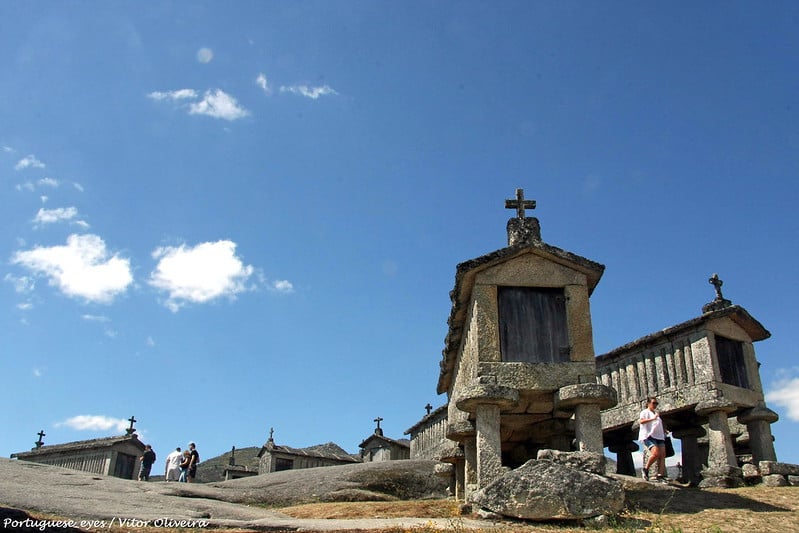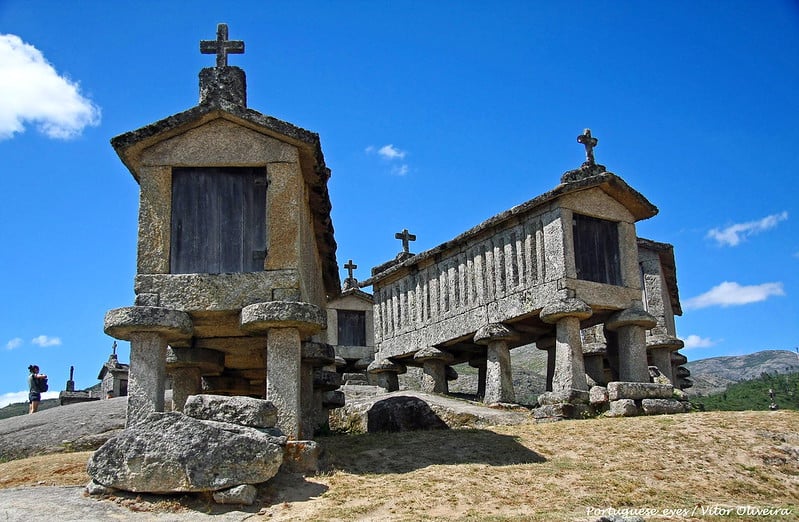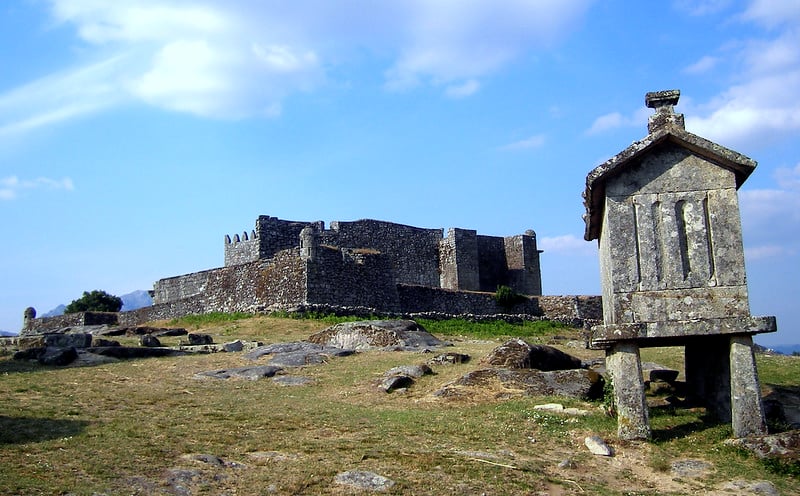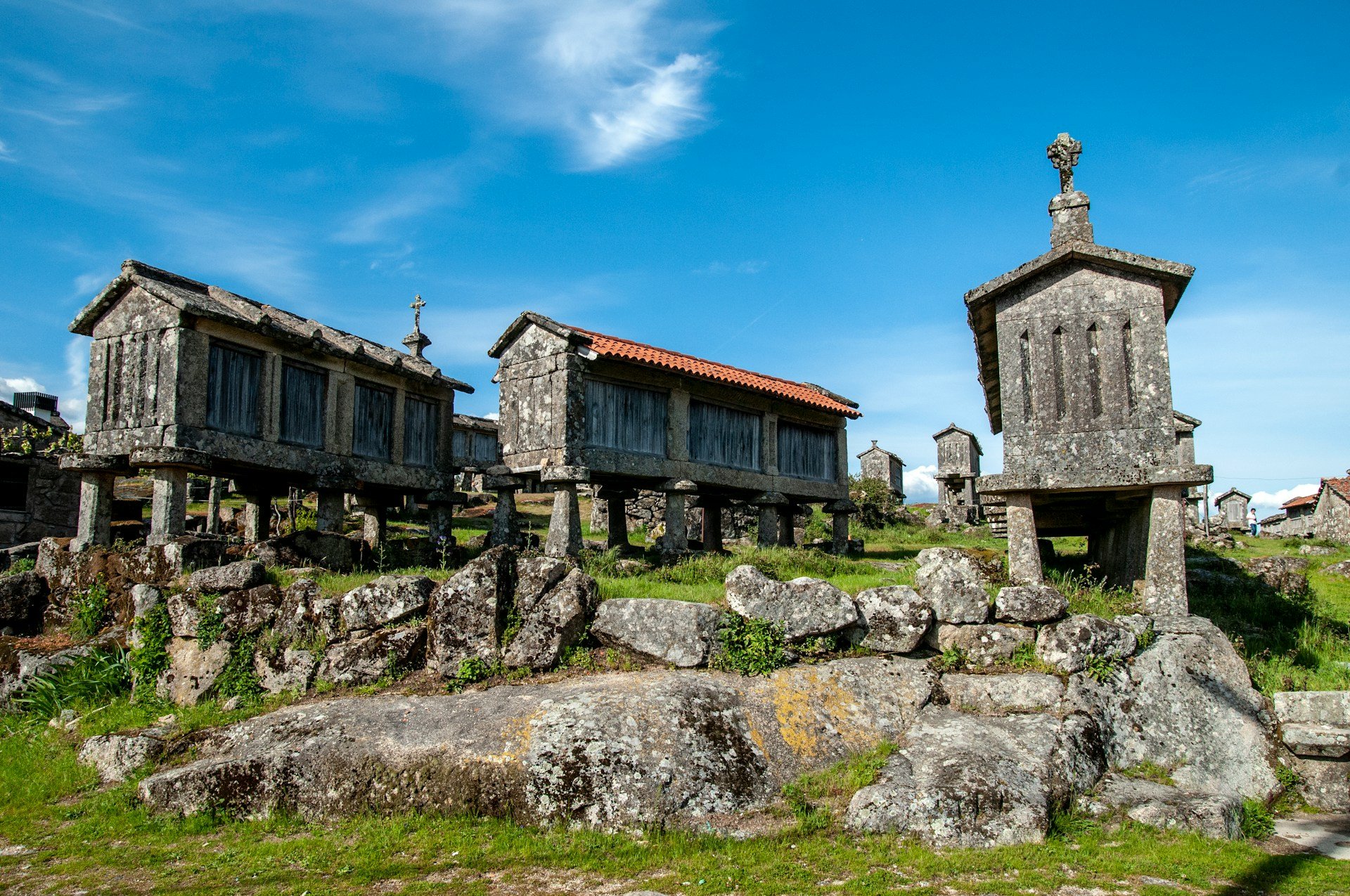When traveling through the mountainous villages of northern Portugal, you may come across some curious rows of narrow, stone-built structures perched on stilts. At first glance, they might look like tombs or miniature chapels, but their true purpose is more practical and tied to the agricultural traditions of the region. These are espigueiros (singular: espigueiro), the traditional granite granaries that have provided sustenance for Portuguese communities for centuries.
Espigueiros symbolize the practicality, spirituality, and community life that defined Portugal’s agrarian society in the past. They provide a look into the rhythms of northern Portuguese villages, where survival depended on careful planning, shared labor, and protection of the harvest.
Origins and Purpose of the Espigueiros
The espigueiro was designed to serve one essential role: preserving grain crops such as corn, wheat, and barley. Each structure is elevated on thick stone pillars and was built mostly of granite sourced from the surrounding mountains. These pillars rest on rounded “mushroom-shaped” bases that prevent rodents from climbing into the granary, which ensure the crops remain safe from pests.
The walls are punctuated with vertical slats or vents that allow the wind to flow through and dry the stored grain. This ventilation was especially crucial because harvests often took place in autumn just before the rainy winter season. By positioning the espigueiros on elevated ground, villagers maximized exposure to wind, which sped up drying and reduced the risk of mold.
On top, slanted granite slabs form a roof, which are often topped with a carved cross. The cross had both spiritual and practical significance. It symbolized divine blessing and discouraged birds from perching on the granary. At the entrance, rough-hewn stone steps provided access to the grain, which allowed families to climb up and check on their storage.
Each espigueiro belonged to a family, passed down through generations, and became a visible reminder of their work, land, and the long agricultural history in the region.

Soajo
One of the most famous sites to see espigueiros is in Soajo, a small village in the Peneda-Gerês mountains, just south of the Spanish border. This charming settlement on the edge of Peneda-Gerês National Park features 24 granaries, most of which date from the late 18th to early 19th century.
Unlike Lindoso, where each espigueiro is owned by a family, Soajo’s cluster has long been regarded as a communal resource, which reflects the cooperative spirit of rural life. Villagers would gather in autumn to thresh grain, clean it, and store it collectively. This shared use created strong bonds between neighbors, who relied on one another for survival.
Festivals and rituals often accompanied these harvest activities. Storing grain was not only practical but also spiritual, entwined with traditions, blessings, and prayers for our daily bread.
Location – Soajo, Portugal
📍 Granaries of Soajo on Google Maps

Lindoso
Just 10 kilometers (6 miles) from Soajo lies another village equally famous for its espigueiros: Lindoso. Here, more than 50 espigueiros stand together on a raised communal threshing ground, a dramatic sight against the backdrop of the medieval Lindoso Castle.

Some of these granaries date back as far as the 17th century, while others are more recent and show signs of repairs and additions over the years. The clustering of espigueiros led historians at first to assume that they reflected a communal way of life. However, later research suggested a different explanation: building them in one place made them easier to guard against thieves.
Even today, some of the granaries in Lindoso remain in use and store corn for local families. Their preservation is a testament to their enduring practicality as well as the determination of the community to honor their traditions.
Location – Lindoso, 4980-020, Portugal
📍 Lindoso Granaries on Google Maps

Cultural Significance
The presence of a cross atop many espigueiros reflects the deep religious culture of the Minho region. While it symbolized divine protection over the grain, it also links back to older folk traditions related to land, fertility, and the cycles of life and death. On a pragmatic level, the cross discouraged birds from perching on the roof and reduced the risk of damage to the structure.
The espigueiros also became gathering points for community life. During harvest, families and neighbors worked side by side, exchanging knowledge and passing down skills to younger generations. They became the centerpieces of village rituals and reinforced bonds that extended beyond the mere storage of grain.
Similarities Beyond Portugal
Espigueiros are not unique to Portugal. Across the border in Galicia, Spain, you can find nearly identical structures called hórreos, which served the same purpose of protecting grain from moisture and pests. Both traditions highlight how agrarian communities across the Iberian Peninsula adapted to similar environmental challenges.
Today, many of these granaries have been restored and legally protected, which ensure that they remain part of the landscape for generations to come.
Visiting the Espigueiros
A visit to the granaries of Lindoso and Soajo is like stepping back in time. Surrounded by mountains, medieval castles, and stone-built villages, we consider these clusters to be some of the most photogenic spots in northern Portugal.
The two sites are only a 20-minute drive apart, which makes it easy to visit both of them in a single trip. Between them, you’ll also find small restaurants and cafés where you can enjoy a hearty Portuguese meal after exploring the granaries. Their proximity to Peneda-Gerês National Park makes them an ideal stopping point along your journey through Northeastern Portugal.
From major cities, the distances are:
- Porto to Lindoso/Soajo – approximately 90 minutes by car (about 120 km).
- Braga to Lindoso/Soajo – about 1 hour by car (70 km).
Why Espigueiros Still Matter
Though modern silos and agricultural techniques have replaced espigueiros in most places, these stone granaries are a direct link to Portugal’s past. Preservation efforts continue to protect their cultural significance. Local councils, museums, and historical societies are working to restore damaged granaries, educate visitors, and celebrate the role these structures played in Portuguese rural life.
For visitors, espigueiros are a chance to appreciate the craftsmanship and wisdom of generations past.
Suggested Itinerary – A Day Trip from Porto or Braga
Here’s a suggested route if you’re planning a visit to Lindoso and Soajo:
Morning
- Depart Porto (around 8:00 am) or Braga (around 9:00 am).
- Drive northeast toward Peneda-Gerês National Park
- Stop at Soajo first, where you can walk among the 24 espigueiros and explore the village square
Midday
- Head to Lindoso (20 minutes by car). Wander among the 50 granaries clustered beside the castle and take in the panoramic views of the surrounding countryside.
- Visit Lindoso Castle, a medieval fortress with sweeping views of the Spanish borderlands.
Lunch
- Enjoy a traditional Portuguese meal at Café Restaurante Mó or another local spot. Try regional dishes such as bacalhau à minhota or roasted goat (cabrito assado).
Afternoon
- Take time to explore Peneda-Gerês National Park, either with a short hike or a drive through its rugged landscapes. Waterfalls, mountain lakes, and ancient villages dot the park and will give you plenty of opportunities for great photos.
Evening
- Return to Porto or Braga, arriving back in time for dinner.
Conclusion
Visiting the espigueiros of Lindoso and Soajo gives you the chance to experience a slice of Portugal’s agricultural past and enjoy a reminder of the ingenuity that sustained rural families for centuries.
The history, the architecture, and the breathtaking landscapes of Peneda-Gerês and the espigueiros are sure to take your breath away.
Tours
Peneda-Gerês Hiking & Sightseeing: Private Experience
Explore North Portugal Barcelos Soajo and Vinho Verde
E-Bike Guided Tour Vale do Lima and Parque Nacional Peneda-Gerês
4h Buggy Tour • Arcos de Valdevez • Peneda Gerês


